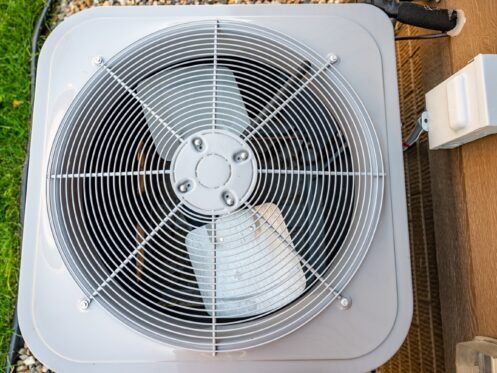When the summer heat sets in, homeowners in Raleigh, NC, depend on their home’s air conditioner to stay comfortable. However, an AC can only do its job effectively if you’ve chosen a system that’s the right size to serve the space you’re trying to cool. So, if you’re in the market for a new AC system for your home, it’s helpful to understand what goes into proper AC sizing. There are three basic ways to go about the process, each more precise than the last. Here’s what they are and how you can choose the right size AC for your home.
A Word on AC Sizes
Before you can select the right size AC for your home, you’ll first need to understand how manufacturers refer to the size of residential HVAC systems. Unlike window air conditioners, which you’ll find listed by their BTU output, you’ll find central air conditioners measured in tons.
However, tons aren’t referring to the weight of the AC system. It’s a type of shorthand that replaces BTUs since those numbers become fairly large at the scale of a whole-house air conditioning system. To convert between the two, you only need to do some simple math. You see, one ton is equivalent to 12,000 BTUs. Knowing that makes it easy to understand the sizing scale you’ll find on all central AC systems.
The Basic Estimation Method
The most straightforward way for you to figure out your home’s AC needs is to go by your home’s square footage. In general, you’ll need approximately 20 BTUs of cooling capacity for each square foot in your home. So, if you owned a 2,000-square-foot home, your baseline cooling estimate would call for a system that provides 40,000 BTUs of cooling power.
The trouble is that if you try to convert 40,000 BTUs into tons, you’d end up with an uneven number of 3.33 tons. However, central air conditioners only come in half-ton increments. In that situation, you’d need to round up to a 3.5-ton AC system. That would ensure that you’d have the required cooling power with some to spare. That’s not your final answer, though.
Next, you’d need to consider some of your home’s specific characteristics. Some things might alter your home’s baseline cooling requirements. For example, if you have ceilings higher than the standard eight feet, you’ll need extra cooling power. Generally, you’ll need an additional 1,000 BTUs for each foot above the standard ceiling height per room. So, if you have two rooms with ten-foot ceilings, you’d need an extra 4,000 BTUs of cooling power. Then, you’ll want an additional 4,000 BTUs for your home’s kitchen. That will ensure you have the cooling capacity to stay comfortable when you’re cooking in the summer.
In truth, countless factors affect proper air conditioning sizing. Therefore, you should only expect an approximate figure to result from the above method. You should end up with a ballpark figure that you can use in your preliminary searches for your home’s next AC system.
AC Sizing by Zone
A slightly more precise way to figure out what size air conditioning system your home needs factors in the specific climate where you live. Here in the US, there are five climate zones, each with specific cooling capacity guidelines. Raleigh is a part of Zone 2, the second warmest zone in the US. The following are the cooling guidelines for homes of different sizes within Zone 2.
- 1.5 tons for homes between 600 and 950 square feet
- 2 tons for homes between 951 and 1250 square feet
- 2.5 tons for homes between 1251 and 1550 square feet
- 3 tons for homes between 1501 and 1850 square feet
- 3.5 tons for homes between 1851 and 2150 square feet
- 4 tons for homes between 2151 and 2500 square feet
- 5 tons for homes between 2501 and 3100 square feet
Of course, you’ll still need to account for the factors in your home that call for additional cooling capacity. However, since the chart above provides home size ranges for each AC size, you may find that any additions still don’t push you into a larger AC size category. Therefore, this method offers a slightly quicker way for you to estimate your home’s cooling needs.
The Manual J Calculation
The most precise way to determine what size AC your home needs is to perform a Manual J calculation. This is how professional HVAC installers approach AC sizing, and it isn’t something you can do on your own. Manual J is a guide created by the Air Conditioning Contractors of America (ACCA), that allows for detailed and precise calculations of a building’s cooling needs. It contains specific data that allows an HVAC installer to properly account for every aspect of your home’s heat load.
Here’s a rough idea of how a Manual J calculation works. To start, the HVAC installer will begin with the square footage of your home. Then, they’ll perform a detailed evaluation of your home’s insulation. This will include checking on your home’s windows and the overall sun exposure that they see each day. They’ll also consider how many people typically occupy your home at any given time and how many exterior doors your home has.
Next, they’ll take a look at the appliances within your home. They’ll ask you how often you use the major heat-producing appliances, as well as the times of day you’re apt to do so. From there, they’ll use the information in Manual J to calculate the additional expected heat load produced by those appliances in a given day.
Finally, the HVAC installer will plug all of the data they’ve collected into the Manual J formula. The formula considers multiple factors independently, then adds them together to arrive at your home’s total heat load. The final Manual J calculation looks something like the following:
- Total square feet of each room X the height of its ceiling
- Number of people in your home X 100 BTUs
- Number of exterior doors and windows X 1,000 BTUs
- Number of additional heat-producing elements X their heat load values
The specific BTU values in the above example would, of course, depend on factors like your home’s insulation quality and sun exposure. After adjusting for that, the HVAC installer would tally their results to arrive at the precise AC size required to efficiently cool your home.
Let the AC Experts Help
In many cases, it’s best to have a Manual J calculation performed for your home before you purchase a new central AC system. Thermo Direct can handle that for you, along with every other phase of the AC purchase and installation process. We offer complete HVAC installation, repair, and maintenance services and work with the latest AC systems from all of the major manufacturers. We can even handle any electrical and plumbing work you require, plus a variety of other useful home health and comfort services from smart thermostats to air quality to spray insulation.
So, when your Raleigh home needs a new AC, don’t take chances and call Thermo Direct to help you get the job done right!







